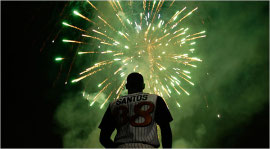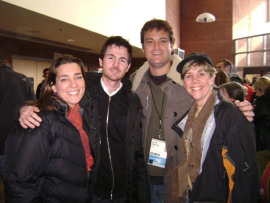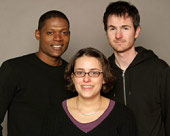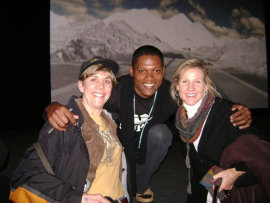 The Sundance Institute has spent two decades building what is widely recognized as the world's premier showcase for American and international independent films. The Utah film festival - with more than 50,000 attendees - converges on the ski town of Park City each January.
The Sundance Institute has spent two decades building what is widely recognized as the world's premier showcase for American and international independent films. The Utah film festival - with more than 50,000 attendees - converges on the ski town of Park City each January.
Hundreds of films launched at the festival have gained critical recognition, received commercial distribution, and reached wider audiences (such as the Quad Cities).
Because of our love of film, three friends and I - all of us with Iowa roots - embarked on the mission of learning all things Sundance. Beyond its reputation for star sightings, private parties, and back-room deals, Sundance hides a secret: It is not an "invite only" event.
The limited number of hotels in Park City will cost more than $400 per person per night during Sundance. Better, more-economical bets are the bounty of rental condos in Park City proper as well as in ski areas such as Deer Valley and The Canyons. We targeted our online search for Park City during the second week of the festival and found a two-bedroom place with ample space and the convenience of a kitchen. The added expense of a rental car isn't necessary, as parking spaces are at a premium and shuttles are in abundance.
Festival passes and ticket packages sell out months in advance. We began our search for tickets in September 2007 for the 2008 festival. Individual tickets are available through a multi-step ticket-registration process. Sundance warns that inventory is limited and even early sign-up cannot guarantee registrants a time slot or pass/package availability. We decided our chances were greater if all four of us registered for the initial ticket-package lottery through (festivaltickets@sundance.org).
 On October 12, two of us were notified by e-mail that we were randomly selected to receive a time slot, phone number, and Web link to use for the right to purchase a ticket package. The person with the earliest time slot purchased the $620 package with 20 festival film tickets. Yet another lottery then gave the purchaser an appointment for ordering screening tickets. Fortunately, our small number worked in our favor, as the maximum number of tickets allotted for any one screening is four.
On October 12, two of us were notified by e-mail that we were randomly selected to receive a time slot, phone number, and Web link to use for the right to purchase a ticket package. The person with the earliest time slot purchased the $620 package with 20 festival film tickets. Yet another lottery then gave the purchaser an appointment for ordering screening tickets. Fortunately, our small number worked in our favor, as the maximum number of tickets allotted for any one screening is four.
The 2008 Sundance festival included 87 films having their world premieres. There were 47 international features and 42 international shorts in the 2008 lineup. Festival screens were lit up with stories from 35 countries, including Romania, Columbia, Hong Kong, Lebanon, Australia, Denmark, Japan, Panama, and Jordan.
At 3:30 p.m. Central on January 4, we logged in - two of us worked together to comprehend the system and provide moral support - to choose our five screenings. Our quartet had gone online and perused the vast list of options prior to the purchase time. The film descriptions, casts, and directors involved, along with the dates of our stay and screening locations, served as our criteria. We ranked our films in order of preference. It helped to have a long list of choices, because many of our top picks were sold out by the time we were allowed to buy tickets on the Web.
We decided on screenings ranging from those in the "World Dramatic" category (foreign films) to "Dramatic Competition." We chose the Jordanian film Captain Abu Raed; Mermaid, a Russian fairy tale; Mysteries of Pittsburgh, adapted from a Michael Chabon novel; a black-and-white French film called I Always Wanted to Be a Gangster; and Sugar, the story of a baseball player from the Dominican Republic who lands in the American minor leagues.
For film lovers, one of the coveted features of Sundance is watching a film in a full theatre. Tickets and passes are not easy to come by, so all screenings are filled with ticket holders, who must arrive a minimum of 15 minutes before the screening.
The Eccles Theatre -a venue that holds 1,300 people - was standing-room-only for our screening of Sugar, with its hometown-ties. Approximately 70 percent of this indie film was shot in Davenport - including John O'Donnell Stadium (now Modern Woodmen Park) - in 2007. The movie was written and directed by Anna Boden and Ryan Fleck, who had success in their first independent dramatic feature: Half Nelson, which premiered at the 2006 Sundance festival.
 Sugar gives an enlightening look at America's national pastime. The story opens as Miguel "Sugar" Santos shows his pitching prowess to scouts in the Dominican Republic. He exudes a gentle celebrity both at a training camp and in his neighborhood, where family and friends ask about his chances of getting to America. At 19, he receives a break and is sent off to spring training in Arizona, then lands a place in the minors with a team in Iowa. Placed like an exchange student with a local family, Sugar starts out pitching well. But as he faces the realities of language barriers, the transfers of his closest friends, and shaken confidence, he starts to question his life's ambition.
Sugar gives an enlightening look at America's national pastime. The story opens as Miguel "Sugar" Santos shows his pitching prowess to scouts in the Dominican Republic. He exudes a gentle celebrity both at a training camp and in his neighborhood, where family and friends ask about his chances of getting to America. At 19, he receives a break and is sent off to spring training in Arizona, then lands a place in the minors with a team in Iowa. Placed like an exchange student with a local family, Sugar starts out pitching well. But as he faces the realities of language barriers, the transfers of his closest friends, and shaken confidence, he starts to question his life's ambition.
We were pleasantly surprised at the number of scenes shot in Davenport and environs. Area baseball players and fans were used in many stadium scenes (shot in September) to help depict the road to the majors. Sugar's directors use close-ups of faces and naturalistic performances to tell this story of self-discovery, as Santos tries to make a name for himself, to make ends meet while sending money home to his family, and to make his way in a land not his own. They paint a less-than-glamorous picture of Santos' journey.
Our Iowa connection to Sugar made its viewing even sweeter, with its captivating scenes from home on the big screen and a distinctly positive rumbling after the show. We learned quickly that those involved in the film and its making wanted to be intimately connected to the Sundance experience, attending the screenings to hear audience reaction.
Following each Sundance screening, if a representative from the film is available, the audience may stay for a question-and-answer session. After all five films, we were thrilled by the presence of a director eager to answer questions about the making of his or her film. In addition to directors, four of the screenings included principal cast members and producers who were willing to share, as well.
After Sugar, directors Boden and Fleck, producer Jamie Patricof, and lead actor Algenis Perez Soto took the stage with 15 others involved in its production. This was their moment to revel in the audience reaction: They received a standing ovation from a full house at the festival's largest venue.
Proudly wearing a Kinnick Stadium cap and my vintage University of Iowa shirt emblazoned with Herky the Hawkeye, I asked, "Sugar was obviously filmed in several locations - including the Dominican Republic and Arizona. I came from Davenport, Iowa, to see the film and wondered if you could respond to your experience filming in Iowa."
 Fleck smiled and said, "I'd like to quote the film Field of Dreams: 'Is this heaven? No, it's Iowa.' Filming in Iowa felt like heaven to us. We started filming in the Dominican Republic, which had its share of challenges. In Iowa there was no language barrier, it was easy to find assistance, and we spent about two weeks on location. There were also 700 great extras willing to perform in the film."
Fleck smiled and said, "I'd like to quote the film Field of Dreams: 'Is this heaven? No, it's Iowa.' Filming in Iowa felt like heaven to us. We started filming in the Dominican Republic, which had its share of challenges. In Iowa there was no language barrier, it was easy to find assistance, and we spent about two weeks on location. There were also 700 great extras willing to perform in the film."
There is an authenticity in the film in its perspective on how baseball promises an easy road to fame, fortune, and hero status. When asked where he got the idea for the movie, Fleck said, "I have always been a baseball fan but learned that every major-league team has an academy in the Dominican Republic - facilities where they sign players for cheap and train them and house them and feed them in hopes that they'll come to the minor-league system here and then become Sammy Sosa."
First-time actor Perez Soto explained that he was discovered for this role while playing baseball. He joked that he almost skipped the tryout so as not to waste his time. His persuasive portrayal will surprise those who see Sugar and learn that an unknown could emote such truth with his eyes and pitch with accuracy, even perfecting a special knuckleball for the film.
HBO Pictures will debut Sugar on its pay network or give it a theatrical release via its Picturehouse label. Maybe you'll come along for a sweet ride to see Sugar at a local theatre near you sometime next year.
Four ladies from the Quad Cities who saw Sugar at Sundance believe it will resonate with a wider audience with its quiet, emotionally driven story. Sugar pitched a great game at the festival, giving a glimpse into the human side of our national pastime's players.










